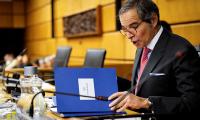Has the story of militant organisations in Pakistan come full circle? Going by the official statements, Pakistan is taking decisive steps to clamp down on such organisations in light of its international obligations and security requirements. The consequences of inaction appear daunting.
The pressure from the Financial Action Task Force (FATF) appears the main motivator this time. Pakistan has already been placed on the ‘grey list’ for not doing enough to tackle the financing of militant organisations. While even the ‘grey list’ designation can harm the nation’s economy, the consequences of the blacklisting can be disastrous.
Pakistan’s militancy problem is four decades old. In the first phase, thousands of Pakistani men joined the jihad in Afghanistan and some of Pakistan’s religio-political parties and groups became closely involved in the militant resistance against the Soviet forces and Soviet-backed Afghan government. Our involvement in the Afghan jihad resulted in the proliferation of small arms, smuggling, narcotics, crimes and religious intolerance.
In the second phase, battle-hardened militant groups got involved in the armed struggle in Indian-occupied Kashmir and also opened a sectarian front within Pakistan. Later, some of these groups became allies of the Taliban government in Afghanistan and found sanctuaries in Kabul while continuing their terrorist activities against minority denominations in Pakistan. Pakistan underwent a sectarian bloodbath during this phase.
The third phase started with 9/11. The fusion of Afghan Taliban, Al-Qaeda and Pakistani jihadi organisations gave birth to the TTP and its different variants. During this phase, most militant groups turned their guns on Pakistani citizens and institutions. The worst period of this phase started with the Lal Masjid operation in Islamabad in 2007, when suicide bombing on public places became the weapon of choice. From its strongholds in Swat and Fata, the TTP, supported by many militant organisations, launched an insurgency that drenched the whole country in blood.
Coming in the wake of dozens of failed agreements and efforts at appeasement and accommodation, the Swat operation, launched in May 2009, proved the beginning of the end for the TTP and its allies. However, it took the nation six more years and the brutal massacre of schoolchildren in Peshawar to formulate the National Action Plan in January 2015. A consensus was developed to undertake an all-out military operation, comprehensive legal reforms and educational initiatives to eliminate extremism and militancy from the country.
Pakistan has come a long way in the last four years. However, during this period the militant organisations that were not posing a direct threat to the state were largely spared. As a result, many Western countries and India blamed Pakistan of harbouring good Taliban, mainly referring to the Haqqani Network, Lashkar-e-Taiba and Jaish-e-Mohammad.
The real picture, though, is a bit complicated as Pakistan-based militant activities in Kashmir almost came to a halt after 2008. According to P Chidambram, a leading Indian politician, between November 26, 2008 and May 26, 2014, not a single terrorist incident in India could be traced back to Pakistan.
However, this did not result in a thaw in India-Pakistan relations or any respite for Kashmiris. India used Afghan soil to support insurgencies and terrorism in Pakistan and used its military might against peaceful Kashmiri protesters, equating stone pelting teenagers with hard-core militants. Still, India was able to gain considerable ground on the diplomatic front, keeping Pakistan under increasing pressure.
Two incidents in 2016 helped India substantially in its narrative of Pakistan being the epicentre of terrorism in the region. In January 2016, an armed group attacked the Indian Air Force Station in Pathankot and later in September 2016, four militants attacked an Indian Army brigade headquarters near the town of Uri in Indian-occupied Kashmir, killing 19 soldiers. India blamed both attacks on the Jaish-e-Mohammed (JeM).
The Pulwama attacker also claimed association with the JeM through a recorded video statement. However, unlike many earlier attacks, the attacker, Adil Ahmad Dar, was a Kashmiri young man who had been abused by the Indian military. He also relied on explosives that had been acquired locally. Any link between him and the Pakistan based JeM has yet to be established. Still, India was able to successfully link the incident to Pakistan, winning support for its position from many powerful capitals even after attacking Pakistani soil.
Unlike Lashkar-e-Taiba, the JeM appears to have some local history as well. Pervez Musharraf, in an interview to a Pakistani television channel, claimed that the JeM had carried out a suicide attack on him in 2003. If true, this was a rather audacious attempt. Even though an unelected dictator, Musharraf’s assassination might have had serious consequences for the nation. Musharraf admitted that he was unable to take any action against the group because of the complicated environment.
Pakistan started banning militant outfits in 2002 and it is still in the process of dealing with them, still unclear whether they should be isolated from the mainstream or helped to get mainstreamed. Taking action against militant groups is difficult because they are far more than a group of armed persons undertaking a militant struggle for some cause.
Apart from hierarchical organisations, these groups are horizontal networks and communities of interpretation that can be resembled to a sect or school of thought. They are distinct from most other Muslim sects as they do not believe in the authority or monopoly of the state in using violence internally or externally. Some of these organisations espouse ‘takfeeri’ views ie they believe that many Muslims, in light of their criteria, are infidels who can be legitimately killed. All of these groups reduce religion to one of its tenets – Jihad – while defining it in their own terms.
This community of interpretation or ideology provides the ground for mobilisation and becomes the basis of various networking efforts. These networks may sustain even when the vertical organisation is eliminated, and retain the capacity to spawn more organisations. Networks are known to have amazing resilience as has been noted by Niall Ferguson in his recent book ‘The Square and the Tower: Networks and Power, from the Freemasons to Facebook’.
Finally, a militant organisation itself provides the institutional structure for the propagation of ideology, networking and undertaking organised militant activities.
While it is important to reintegrate individuals from extremist organisations into mainstream society, in most cases it can be extremely ill-advised to mainstream a whole organisation and let it continue its work under a different umbrella. It is important that such groups are deprived of their institutional infrastructure and not allowed to re-group under any guise or any circumstances. Starving the organisation and their key members of any visible or invisible financing is an important part of the strategy.
Not all followers of extremist ideologies take up arms. They are usually militarised through some training and provision of small arms. Any effort at militarisation throws a direct challenge to the writ of the state, which is the only entity that can legitimately use force in a legal manner. While worrying less about the hate speech, Pakistan must be fully focused on use of violence (or potential use) and incitement to violence.
We have seen efforts to mainstream groups wholesale through allowing them to turn into charities or political entities. In the absence of any articulated strategy, such efforts have been without any national consensus and have failed to impress the international community as well. The time for such efforts may be over.
Most young men associated with the Kashmir-focused organisation cannot be considered criminal if the crime is defined as deviance ie diverging from usual or accepted standards. They were involved in what a good part of the community considered a just cause. They remain integrated in their communities and any action against them will be extremely ill-advised and counterproductive. Their energies should be diverted to other efforts through a well-thought-out strategy, while ensuring them that the state and its institutions are fully capable of fulfilling their duties.
Pakistan must build on its earlier successes and proceed softly and wisely, establishing the writ of the state and rule of law for a better and prosperous future for its citizens.
The writer is an anthropologist and development professional.
Email: zaighamkhan@yahoo.com
Twitter: @zaighamkhan
Data, today, defines how we make decisions with tools allowing us to analyse experience more precisely
But if history has shown us anything, it is that rivals can eventually unite when stakes are high enough
Imagine a classroom where students are encouraged to question, and think deeply
Pakistan’s wheat farmers face unusually large pitfalls highlighting root cause of downward slide in agriculture
In agriculture, Pakistan moved up from 48th rank in year 2000 to an impressive ranking of 15th by year 2023
Born in Allahabad in 1943, Saeeda Gazdar migrated to Pakistan after Partition







